brake light TOYOTA TACOMA 2018 Owners Manual (in English)
[x] Cancel search | Manufacturer: TOYOTA, Model Year: 2018, Model line: TACOMA, Model: TOYOTA TACOMA 2018Pages: 696, PDF Size: 11.72 MB
Page 3 of 696

3
1
9 8
7 5 4
3
2
10
6
4-1. Before drivingDriving the vehicle ............. 160
Cargo and luggage............ 170
Vehicle load limits ............. 174
Trailer towing..................... 175
Dinghy towing.................... 192
4-2. Driving procedures Engine (ignition) switch (vehicles without
a smart key system) ........ 193
Engine (ignition) switch (vehicles with a smart
key system) ..................... 196
Automatic transmission ..... 201
Manual transmission ......... 207
Turn signal lever................ 209
Parking brake .................... 210
4-3. Operating the lights and wipers
Headlight switch ................ 211
Automatic High Beam ....... 215
Fog light switch ................. 220
Windshield wipers and washer ............................ 221
4-4. Refueling Opening the fuel tank cap .................................. 224 4-5. Using the driving support
systems
Toyota Safety Sense P ...... 228
PCS (Pre-Collision System)..... 235
LDA (Lane Departure Alert)..... 249
Dynamic radar cruise control ................... 257
Cruise control .................... 271
Intuitive parking assist ....... 275
Rear view monitor system ............................. 281
BSM (Blind Spot Monitor)......... 291
• T he Blind Spot Monitor
function .......................... 293
• T he Rear Cross Traffic
Alert function ................. 296
Four-wheel drive system ... 299
AUTO LSD system ............ 303
Rear differential lock system ............................. 305
Active traction control system ............................. 308
Multi-terrain Select............. 310
Crawl Control ..................... 314
Clutch start cancel switch .............................. 318
Driving assist systems ....... 319
4-6. Driving tips Winter driving tips .............. 325
Off-road precautions .......... 329
4Driving
Page 17 of 696
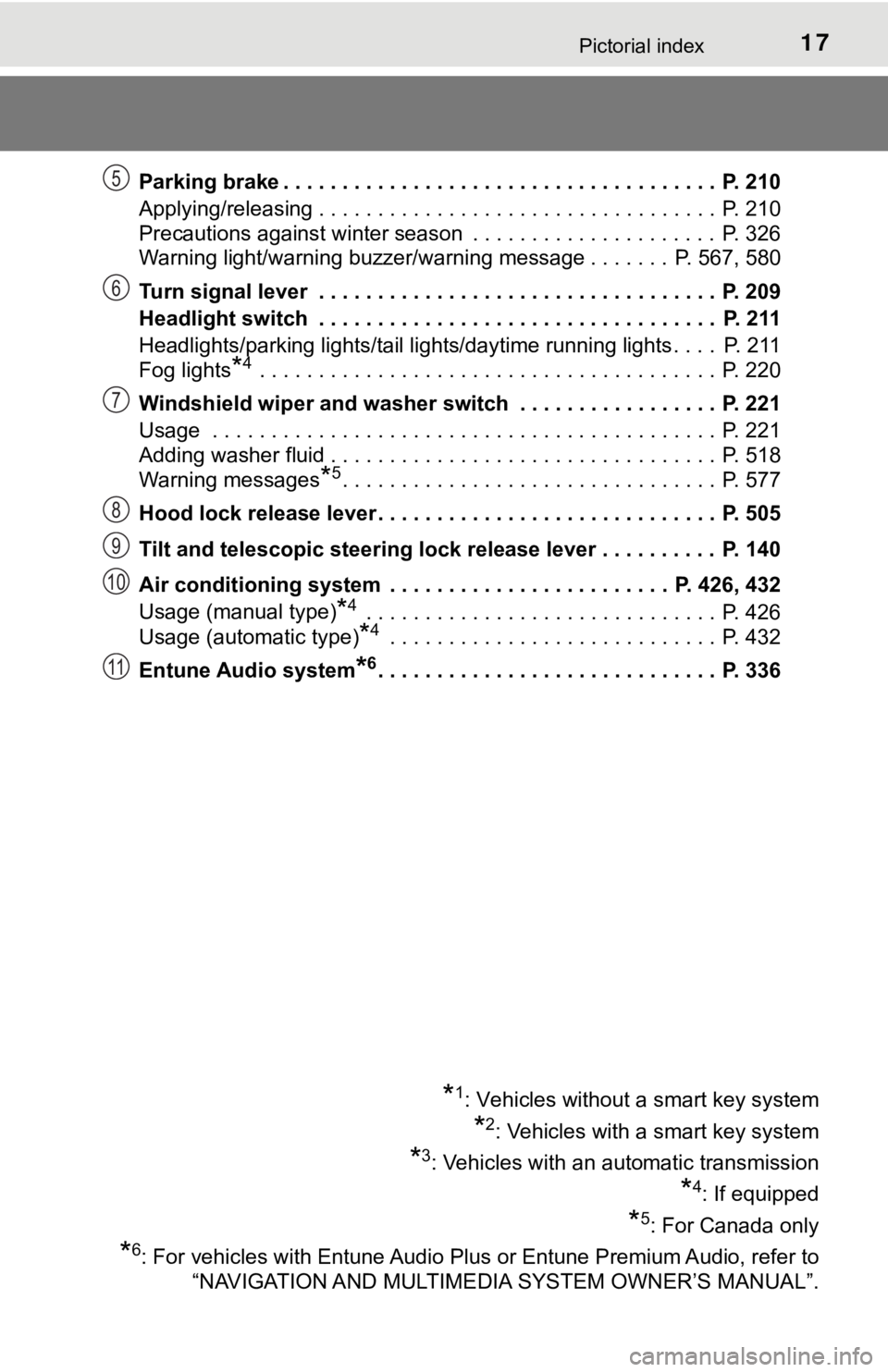
17Pictorial index
Parking brake . . . . . . . . . . . . . . . . . . . . . . . . . . . . . . . . . . . . . P. 210
Applying/releasing . . . . . . . . . . . . . . . . . . . . . . . . . . . . . . . . . . P. 210
Precautions against winter season . . . . . . . . . . . . . . . . . . . . . P. 326
Warning light/warning buzzer/warning message . . . . . . . P. 567, 580
Turn signal lever . . . . . . . . . . . . . . . . . . . . . . . . . . . . . . . . . . P. 209
Headlight switch . . . . . . . . . . . . . . . . . . . . . . . . . . . . . . . . . . P. 211
Headlights/parking lights/tail lights/daytime running lights . . . . P. 211
Fog lights
*4 . . . . . . . . . . . . . . . . . . . . . . . . . . . . . . . . . . . . . . . P. 220
Windshield wiper and washer switch . . . . . . . . . . . . . . . . . P. 221
Usage . . . . . . . . . . . . . . . . . . . . . . . . . . . . . . . . . . . . . . . . . . . P. 221
Adding washer fluid . . . . . . . . . . . . . . . . . . . . . . . . . . . . . . . . . P. 518
Warning messages
*5. . . . . . . . . . . . . . . . . . . . . . . . . . . . . . . . P. 577
Hood lock release lever. . . . . . . . . . . . . . . . . . . . . . . . . . . . . P. 505
Tilt and telescopic steering lock release lever . . . . . . . . . . P. 140
Air conditioning system . . . . . . . . . . . . . . . . . . . . . . . . P. 426, 432
Usage (manual type)
*4 . . . . . . . . . . . . . . . . . . . . . . . . . . . . . . P. 426
Usage (automatic type)
*4 . . . . . . . . . . . . . . . . . . . . . . . . . . . . P. 432
Entune Audio system
*6. . . . . . . . . . . . . . . . . . . . . . . . . . . . . P. 33 6
*1: Vehicles without a smart key system
*2: Vehicles with a smart key system
*3: Vehicles with an automatic transmission
*4: If equipped
*5: For Canada only
*6: For vehicles with Entune Audio Plus or Entune Premium Audio, refer to
“NAVIGATION AND MULTIMEDIA SYSTEM OWNER’S MANUAL”.
5
6
7
8
9
10
11
Page 85 of 696
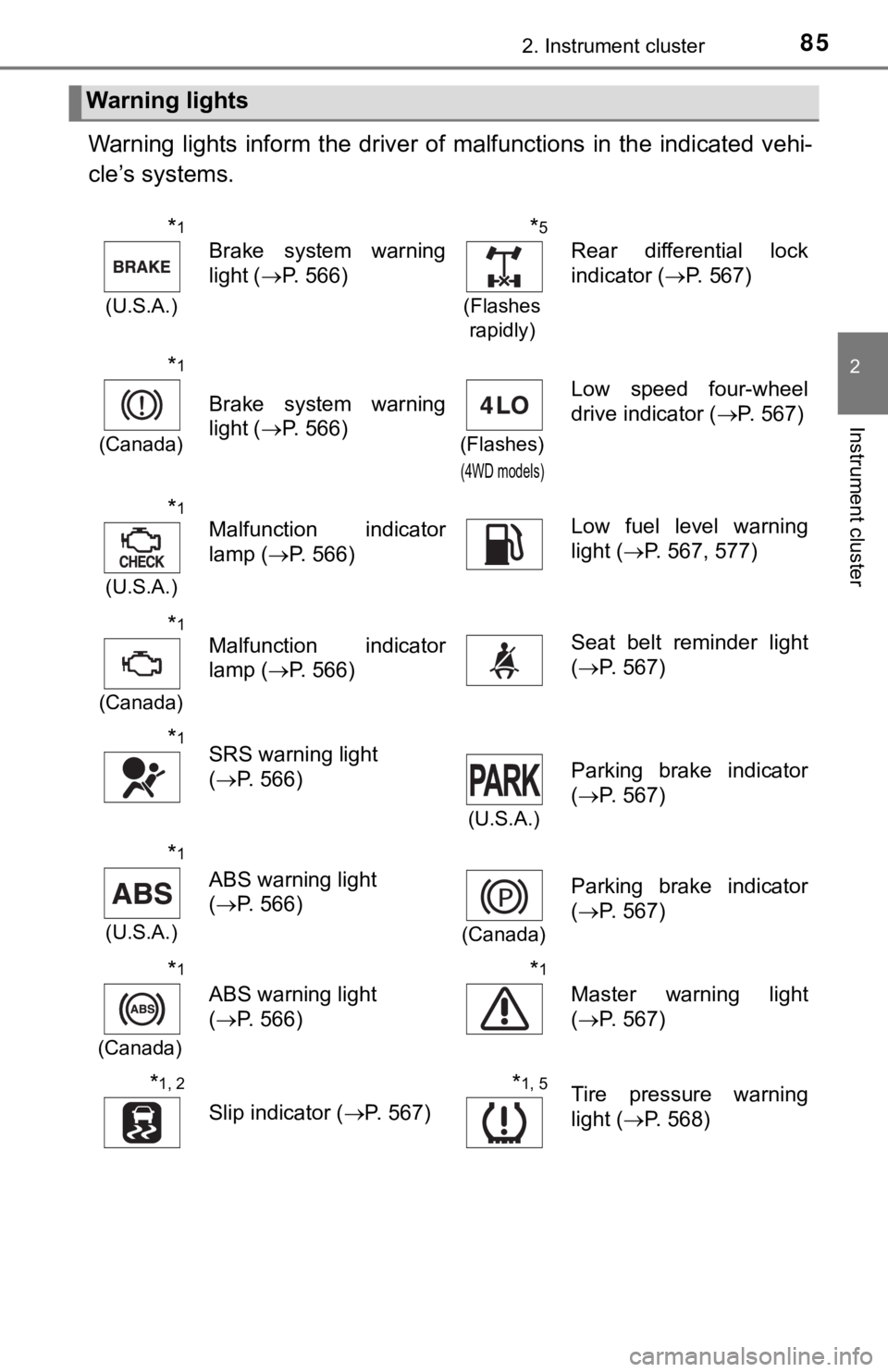
852. Instrument cluster
2
Instrument cluster
Warning lights inform the driver of malfunctions in the indicated vehi-
cle’s systems.
Warning lights
*1
(U.S.A.)
Brake system warning
light ( P. 566)
*5
(Flashes
rapidly)
Rear differential lock
indicator ( P. 567)
*1
(Canada)
Brake system warning
light ( P. 566)
(Flashes)
(4WD models)
Low speed four-wheel
drive indicator ( P. 567)
*1
(U.S.A.)
Malfunction indicator
lamp (P. 566)Low fuel level warning
light (P. 567, 577)
*1
(Canada)
Malfunction indicator
lamp ( P. 566)Seat belt reminder light
(P. 567)
*1SRS warning light
(P. 566)
(U.S.A.)
Parking brake indicator
(P. 567)
*1
(U.S.A.)
ABS warning light
(P. 566)
(Canada)
Parking brake indicator
(P. 567)
*1
(Canada)
ABS warning light
(P. 566)
*1
Master warning light
(P. 567)
*1, 2
Slip indicator ( P. 567)
*1, 5Tire pressure warning
light (P. 568)
Page 86 of 696
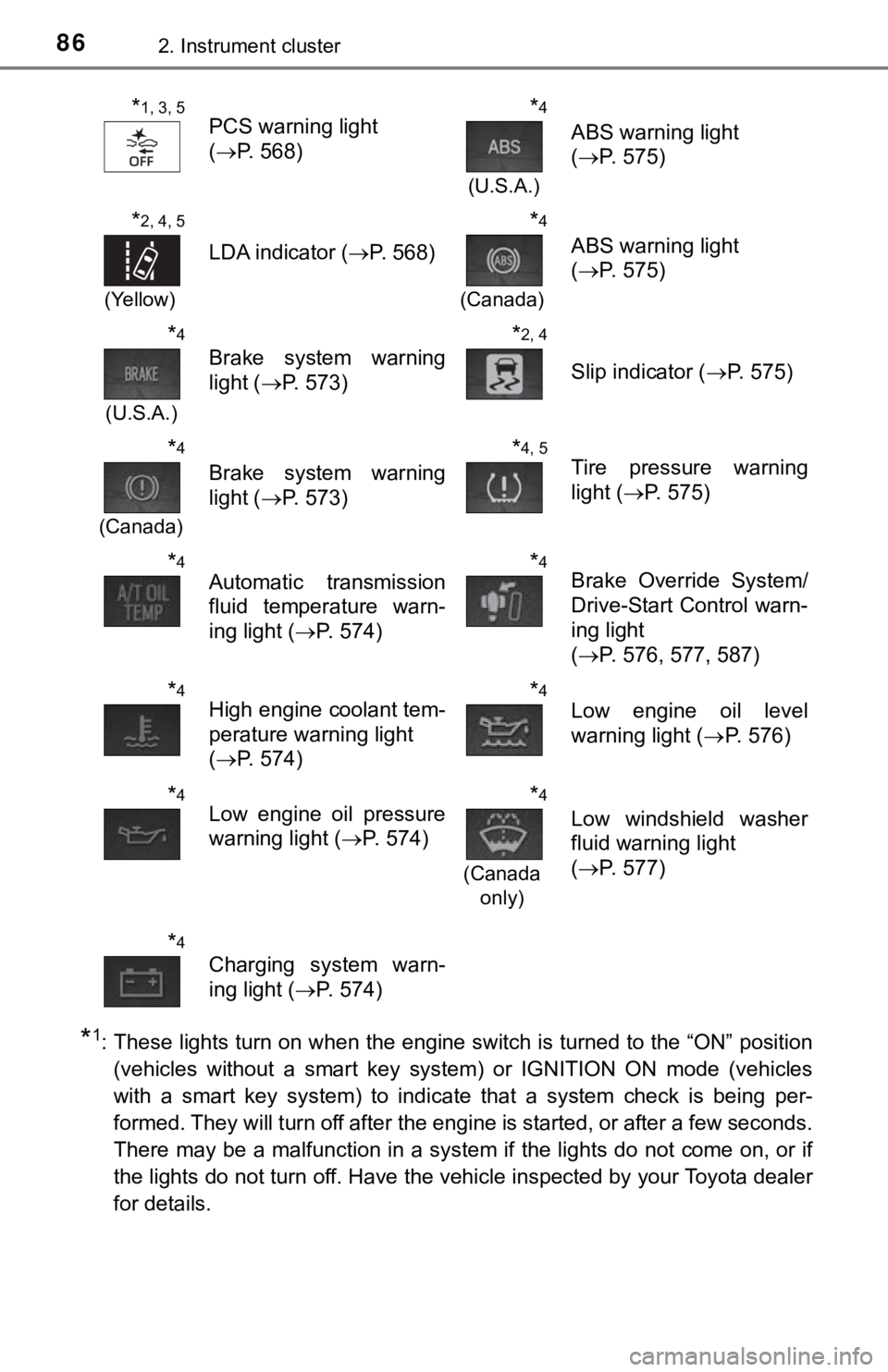
862. Instrument cluster
*1: These lights turn on when the engine switch is turned to the “ON” position(vehicles without a smart key system) or IGNITION ON mode (vehi cles
with a smart key system) to indicate that a system check is bei ng per-
formed. They will turn off after the engine is started, or after a few seconds.
There may be a malfunction in a system if the lights do not com e on, or if
the lights do not turn off. Have the vehicle inspected by your Toyota dealer
for details.
*1, 3, 5PCS warning light
( P. 568)*4
(U.S.A.)
ABS warning light
(P. 575)
*2, 4, 5
(Yellow)
LDA indicator ( P. 568)
*4
(Canada)
ABS warning light
(P. 575)
*4
(U.S.A.)
Brake system warning
light ( P. 573)
*2, 4
Slip indicator ( P. 575)
*4
(Canada)
Brake system warning
light (P. 573)
*4, 5Tire pressure warning
light (P. 575)
*4Automatic transmission
fluid temperature warn-
ing light ( P. 574)*4Brake Override System/
Drive-Start Control warn-
ing light
(P. 576, 577, 587)
*4High engine coolant tem-
perature warning light
(P. 574)*4Low engine oil level
warning light ( P. 576)
*4Low engine oil pressure
warning light ( P. 574)*4
(Canada
only)
Low windshield washer
fluid warning light
(P. 577)
*4
Charging system warn-
ing light ( P. 574)
Page 88 of 696
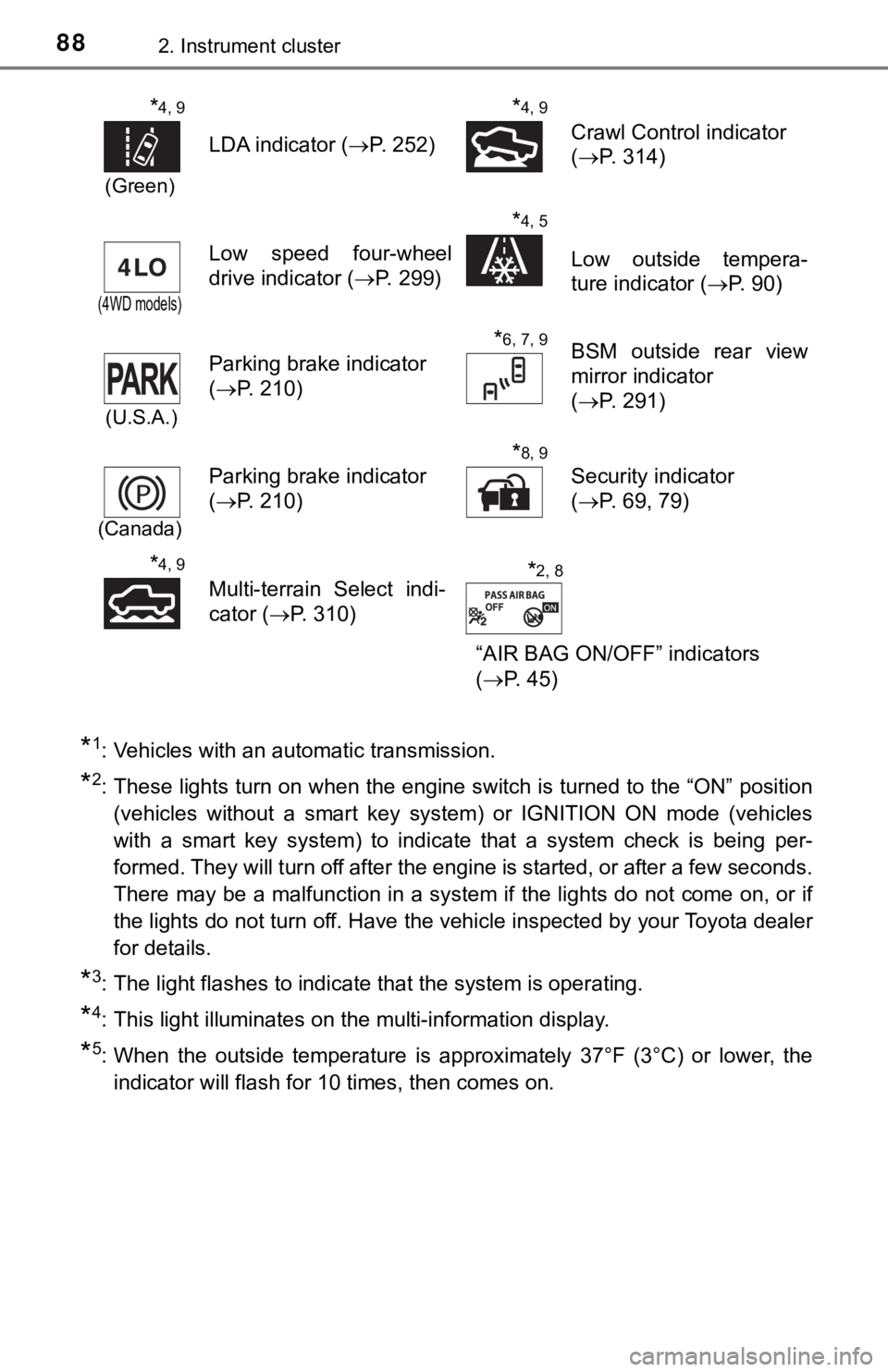
882. Instrument cluster
*1: Vehicles with an automatic transmission.
*2: These lights turn on when the engine switch is turned to the “ON” position(vehicles without a smart key system) or IGNITION ON mode (vehi cles
with a smart key system) to indicate that a system check is bei ng per-
formed. They will turn off after the engine is started, or after a few seconds.
There may be a malfunction in a system if the lights do not com e on, or if
the lights do not turn off. Have the vehicle inspected by your Toyota dealer
for details.
*3: The light flashes to indicate that the system is operating.
*4: This light illuminates on the multi-information display.
*5: When the outside temperature is approximately 37°F (3°C) or lo wer, the
indicator will flash for 10 times, then comes on.
*4, 9
(Green)
LDA indicator ( P. 252)
*4, 9
Crawl Control indicator
(P. 314)
(4WD models)
Low speed four-wheel
drive indicator ( P. 299)
*4, 5
Low outside tempera-
ture indicator (P. 90)
(U.S.A.)
Parking brake indicator
(P. 210)
*6, 7, 9BSM outside rear view
mirror indicator
(P. 291)
(Canada)
Parking brake indicator
(P. 210)
*8, 9
Security indicator
(P. 69, 79)
*4, 9
Multi-terrain Select indi-
cator (P. 310)
“AIR BAG ON/OFF” indicators
(P. 45)*2, 8
Page 158 of 696

158
4-1. Before drivingDriving the vehicle............. 160
Cargo and luggage ........... 170
Vehicle load limits ............. 174
Trailer towing .................... 175
Dinghy towing ................... 192
4-2. Driving procedures Engine (ignition) switch (vehicles without
a smart key system) ........ 193
Engine (ignition) switch (vehicles with a smart
key system)..................... 196
Automatic transmission ..... 201
Manual transmission ......... 207
Turn signal lever ............... 209
Parking brake .................... 210
4-3. Operating the lights and wipers
Headlight switch ................ 211
Automatic High Beam ....... 215
Fog light switch ................. 220
Windshield wipers and washer ............................ 221
Page 161 of 696
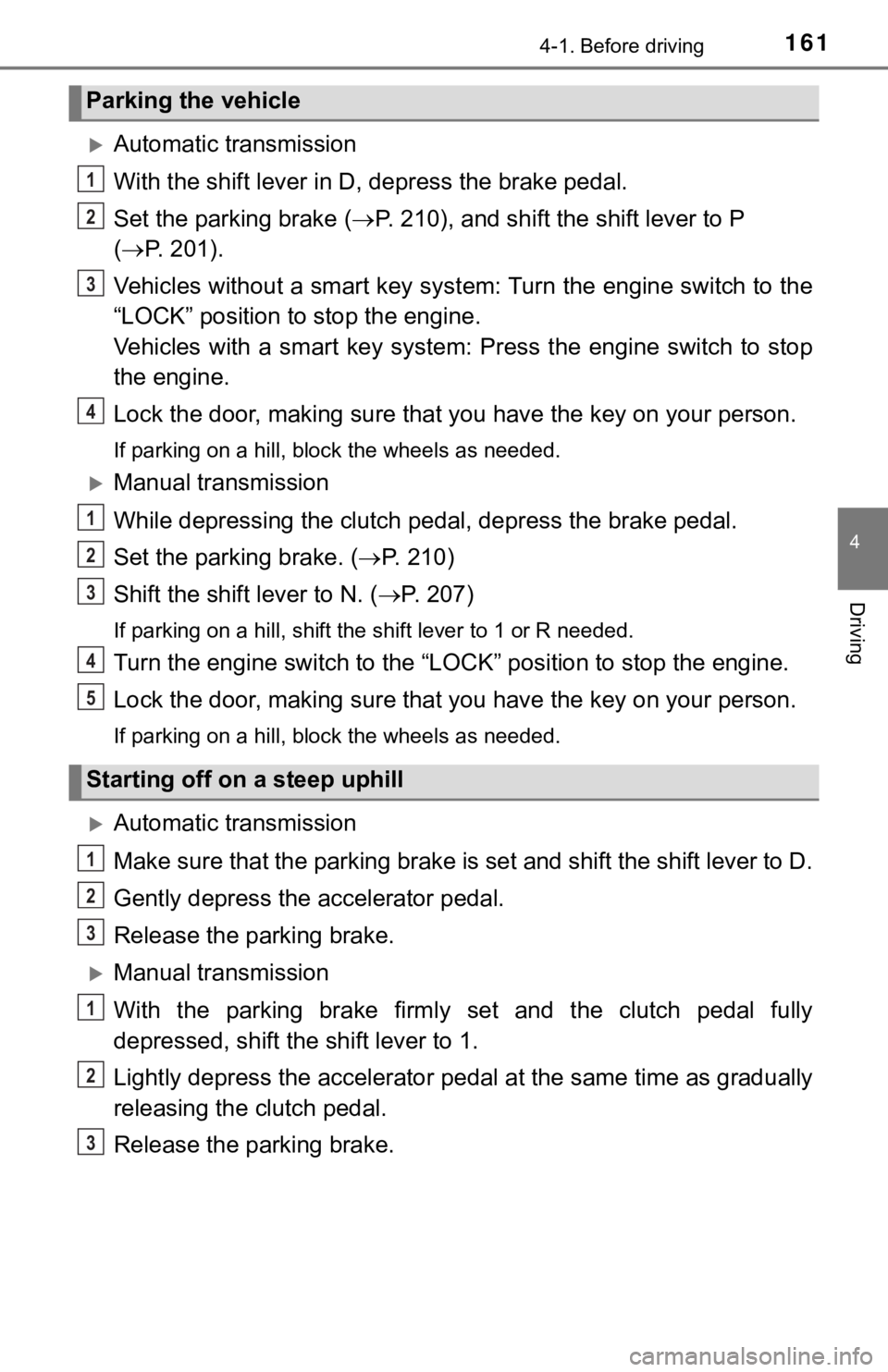
1614-1. Before driving
4
Driving
Automatic transmission
With the shift lever in D, depress the brake pedal.
Set the parking brake ( P. 210), and shift the shift lever to P
( P. 201).
Vehicles without a smart key sys tem: Turn the engine switch to the
“LOCK” position to stop the engine.
Vehicles with a smart key system : Press the engine switch to stop
the engine.
Lock the door, making sure that you have the key on your person.
If parking on a hill, block the wheels as needed.
Manual transmission
While depressing the clutch pedal, depress the brake pedal.
Set the parking brake. ( P. 2 1 0 )
Shift the shift lever to N. ( P. 207)
If parking on a hill, shift the shift lever to 1 or R needed.
Turn the engine switch to the “LOC K” position to stop the engine.
Lock the door, making sure that you have the key on your person.
If parking on a hill, block the wheels as needed.
Automatic transmission
Make sure that the parking brake is set and shift the shift lev er to D.
Gently depress the accelerator pedal.
Release the parking brake.
Manual transmission
With the parking brake firmly set and the clutch pedal fully
depressed, shift the shift lever to 1.
Lightly depress the accelerato r pedal at the same time as gradu ally
releasing the clutch pedal.
Release the parking brake.
Parking the vehicle
Starting off on a steep uphill
1
2
3
4
1
2
3
4
5
1
2
3
1
2
3
Page 164 of 696

1644-1. Before driving
WARNING
Observe the following precautions.
Failure to do so may result in death or serious injury.
■When starting the vehicle (vehic les with an automatic transmission)
Always keep your foot on the brake pedal while stopped with the engine
running. This prevents the vehicle from creeping.
■ When driving the vehicle
● Do not drive if you are unfamiliar with the location of the brake and accel-
erator pedals to avoid depressing the wrong pedal.
• Accidentally depressing the accelerator pedal instead of the b rake
pedal will result in sudden acceleration that may lead to an accident.
• When backing up, you may twist your body around, leading to di fficulty
in operating the pedals. Make sure to operate the pedals proper ly.
• Make sure to keep a correct driving posture even when moving t he
vehicle only slightly. This allows you to depress the brake and accelera-
tor pedals properly.
• Depress the brake pedal using your right foot. Depressing the brake
pedal using your left foot may delay response in an emergency, result-
ing in an accident.
● Do not drive the vehicle over or stop the vehicle near flammable materials.
The exhaust system and exhaust gases can be extremely hot. Thes e hot
parts may cause a fire if there is any flammable material nearb y.
● During normal driving, do not turn off the engine. Turning the engine off
while driving will not cause loss of steering or braking contro l, but the
power assist to these systems will be lost. This will make it m ore difficult to
steer and brake, so you should pull over and stop the vehicle a s soon as it
is safe to do so.
However, in the event of an emergency, such as if it becomes im possible
to stop the vehicle in the normal way: P. 557
● Use engine braking (downshift) to maintain a safe speed when driving
down a steep hill.
Using the brakes continuously may cause the brakes to overheat and lose
effectiveness. ( P. 201, 207)
● Do not adjust the positions of the steering wheel, the seat, or the inside or
outside rear view mirrors while driving.
Doing so may result in a loss of vehicle control.
● Always check that all passengers’ arms, heads or other parts of their body
are not outside the vehicle.
Page 165 of 696

1654-1. Before driving
4
Driving
WARNING
Observe the following precautions.
Failure to do so may result in death or serious injury.
■When driving the vehicle
● Do not drive in excess of the speed limit. Even if the legal sp eed limit per-
mits it, do not drive over 85 mph (140 km/h) unless your vehicl e has high-
speed capability tires. Driving over 85 mph (140 km/h) may resu lt in tire
failure, loss of control and possible injury. Be sure to consult a tire dealer
to determine whether the tires on your vehicle are high-speed c apability
tires or not before driving at such speeds.
■ When driving on slippery road surfaces
● Sudden braking, acceleration and steering may cause tire slippa ge and
reduce your ability to control the vehicle.
● Sudden acceleration, engine braking due to shifting, or changes in engine
speed could cause the vehicle to skid.
● After driving through a puddle, lightly depress the brake pedal to make
sure that the brakes are functioning properly. Wet brake pads m ay prevent
the brakes from functioning properly. If the brakes on only one side are wet
and not functioning properly, steering control may be affected.
■ When shifting the shift lever
● On vehicles with an automatic transmission, do not let the vehi cle roll
backward while the shift lever is in a driving position, or rol l forward while
the shift lever is in R.
Doing so may cause the engine to stall or lead to poor brake an d steering
performance, resulting in an accident or damage to the vehicle.
● On vehicles with an automatic transmission, do not shift the sh ift lever to P
while the vehicle is moving.
Doing so can damage the transmission and may result in a loss o f vehicle
control.
● Do not shift the shift lever to R while the vehicle is moving forward.
Doing so can damage the transmission and may result in a loss o f vehicle
control.
● Do not shift the shift lever to a driving position while the ve hicle is moving
backward.
Doing so can damage the transmission and may result in a loss o f vehicle
control.
● Moving the shift lever to N while the vehicle is moving will disengage the
engine from the transmission. Engine braking is not available w hen N is
selected.
● On vehicles with an automatic transmission, be careful not to s hift the shift
lever with the accelerator pedal depressed. Shifting the shift lever to a
gear other than P or N may lead to moving unexpectedly of the vehicle
that may cause an accident.
Page 166 of 696

1664-1. Before driving
WARNING
■If you hear a squealing or scrap ing noise (brake pad wear limit indica-
tors)
Have the brake pads checked and replaced by your Toyota dealer as soon
as possible.
Rotor damage may result if the pads are not replaced when neede d.
It is dangerous to drive the vehicle when the wear limits of the brake pads
and/or those of the brake discs are exceeded.
■ When the vehicle is stopped
● Do not race the engine.
If the vehicle is in any gear other than P (automatic transmiss ion only) or
N, the vehicle may move suddenly and unexpectedly, causing an a ccident.
● On vehicles with an automatic transmission, in order to prevent accidents
due to the vehicle rolling away, always keep depressing the bra ke pedal
while the engine is running, and apply the parking brake as nec essary.
● If the vehicle is stopped on an incline, in order to prevent ac cidents caused
by the vehicle rolling forward or backward, always depress the brake pedal
and securely apply the parking brake as needed.
● Avoid revving or racing the engine.
Running the engine at high speed while the vehicle is stopped m ay cause
the exhaust system to overheat, which could result in a fire if combustible
material is nearby.
■ When the vehicle is parked
● Do not leave glasses, cigarette lighters, spray cans, or soft d rink cans in
the vehicle when it is in the sun.
Doing so may result in the following:
• Gas may leak from a cigarette lighter or spray can, and may le ad to a
fire.
• The temperature inside the vehicle may cause the plastic lenses and plastic material of glasses to deform or crack.
• Soft drink cans may rupture, causing the contents to spray ove r the
interior of the vehicle, and may also cause a short circuit in the vehicle’s
electrical components.
● Do not leave cigarette lighters in the vehicle. If a cigarette lighter is in a
place such as the glove box or on the floor, it may be lit acci dentally when
luggage is loaded or the seat is adjusted, causing a fire.
● Do not attach adhesive discs to the windshield or windows. Do n ot place
containers such as air fresheners on the instrument panel or da shboard.
Adhesive discs or containers may act as lenses, causing a fire in the vehi-
cle.